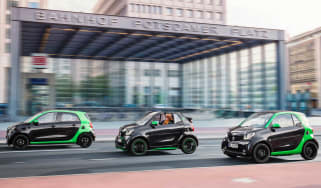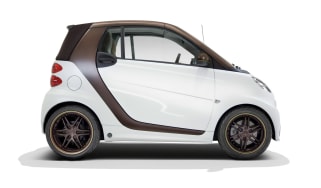Smart ForTwo Cabriolet convertible (2007-2014)
"The highly recognisable Smart ForTwo cabriolet is the smallest convertible car you can buy, and it's ideal for use in built-up areas, where space is at a premium"
Pros
- Unique design
- Great in town
- Very cheap to run
Cons
- Clunky gearbox
- Lack of storage
- Only two seats
The Smart ForTwo cabriolet convertible is an attractive, head-turning car that is also the smallest convertible you can buy in the UK. It has a clever folding-roof design, while its unique city car proposition – low running costs combined with fun in the sun – does making it tempting to buyers who want more than rivals such as the Toyota iQ offer. The current model is slightly larger than the original Smart car but still only measures 2.69 metres in length, so you can still park it at right angles to the kerb – the smart’s unique selling point. The new 1.0-litre petrol petrol engines are reasonably smooth and very frugal, producing very low emissions. The latest 71bhp micro hybrid drive model is also fitted with a stop-start system that helps it to return 67.3mpg. The Smart ForTwo cabriolet comes in three main specifications – entry-level pulse, mid-spec passion and top-of-the-range BRABUS Xclusive.
MPG, running costs & CO2
Like the standard model, the ForTwo convertible is capable of returning 65.7mpg in fuel economy from the 71bhp pulse micro hybrid drive model, fitted with stop-start. The hybrid’s CO2 emissions also fall below the magic 100g/km mark to qualify for free road tax. In an increasingly common trend, however, the CDI diesel is actually more efficient than the hybrid, returning 85.6mpg and emitting only 87g/km of CO2. If you can afford the Electric Drive model then that model will save you the most money, incurring only a minimal increase to your household electricity costs. All models also fall below insurance group seven.
Engines, drive & performance
The convertible ForTwo cabriolet comes with a choice of three 1.0-litre petrol engines - 71bhp, 84bhp or 102bhp. The entry-level model is actually all city drivers will need to get the best out of the nippy runabout, but anyone who intends to regularly drive their Smart on the open road should look higher in the range. There’s generally good visibility, and a very tight turning circle further increases its agility through city traffic. However, twisty roads and roundabouts still highlight the nervous handling that was common in the first-generation models. The jerky semi-automatic gearbox exaggerates this, as it’s clunky even when you switch it to manual mode. This is where the Electric Drive model comes up trumps, ditching the gearbox altogether and becoming immediately more enjoyable to drive as a result. Plus, its instant acceleration makes it even better pulling out of junctions.
Interior & comfort
As soon as you leave the ForTwo’s natural urban-streets habitat, the small, rear-mounted engines across the whole range start to struggle. Once on the motorway or when driving up hills, the engine noise is very loud and tiresome, with only selective acceleration going some way to reducing the din. Also, it’s hard to feel relaxed on the motorway with almost every other vehicle seeming to tower over you, and crosswinds are genuinely unsettling. The seats have been re-designed to be much more comfortable than in the past, though.
Practicality & boot space
Let’s not beat around the bush – the ForTwo cabriolet won’t win any prizes for being practical. While the 220-litre boot is an improvement over the older model, you still can’t load any larger bulky items or suitcases. Plus, it is strictly a two-seater car, but you do get a reasonably sized glove compartment and door bins that can hold mid-sized items such as handbags, bottles and phones. A nice touch is that the removable roof rails slot cleverly into a hidden area behind the boot lid at the back. The main practical plus point for any smart is still its tiny size – if you need to squeeze into tighter-than-tight parking spaces, or just feel like parking sideways on for a quick getaway, there is no better car on the market, so while its general practicality is limited, it is immensely useful for one specific function.
Reliability & safety
No Smart cars rank in the 2013 Auto Express Driver Power customer satisfaction survey’s top 150 cars at all, which is quite telling. Also, Smart itself placed at the very bottom of the manufacturers list in the poll, dropping a further three spots from its 2012 position. This means it’s only avoiding dropping off the list entirely because the survey added two extra places in 2013. However, smart is owned by Mercedes, and the ForTwo uses parts from the rest of the company’s tried-and-tested line-up. The three-cylinder engines should be reliable, but servicing costs are expensive because they come from Mercedes and Smarts are still relatively rare. Plus, the electrical problems that plagued the original Smart cars have been ironed out, so that is a big improvement over the previous model. Basically, you know a Smart isn’t going to be massively safe – most city cars are limited in this regard – and aren’t going to prove as robust as bigger, more durable cars. This is reflected by the ForTwo only getting four stars in the Euro NCAP crash safety tests, which is a bit disappointing when most cars nowadays sail through with the maximum five stars, but it is worth remembering just how small and light the car is. You do get driver and passenger airbags, plus electronic stability control fitted as standard, but side airbags are available as an optional extra only. You actually only have to look at a Smart ForTwo to gauge how reliable it’s going to be – it will serve you well, but anything this small has its limits on the road.
Price, value for money & options
The ForTwo cabriolet’s value is pretty much in line with the standard model. Entry-level pulse models are therefore cheap to buy, but don’t come with very much equipment. You do get air-conditioning, alloy wheels, Bluetooth and electric windows, while Passion models add swankier extras like sat-nav and a panoramic glass roof. The sportier BRABUS comes equipped with heated leather seats and a chunkier body kit. If you use Smart’s Tailor Made service, BRABUS buyers can personalise their car's colour and interior finish with thousands of combinations – but, naturally, it comes at a price.










